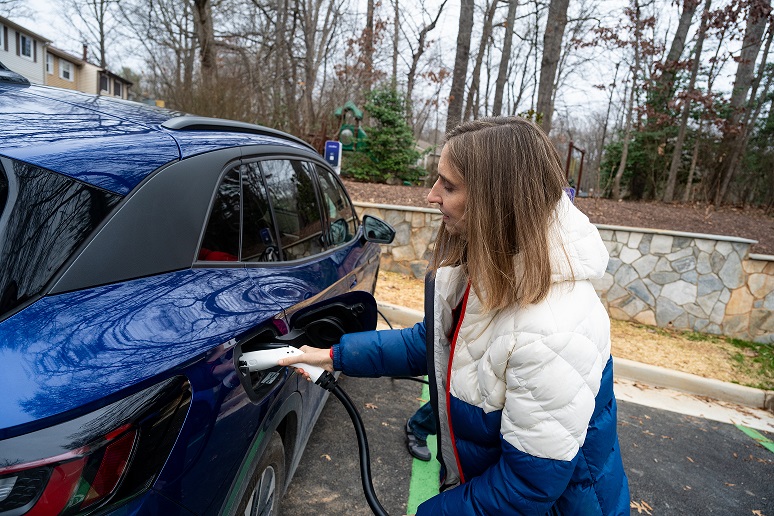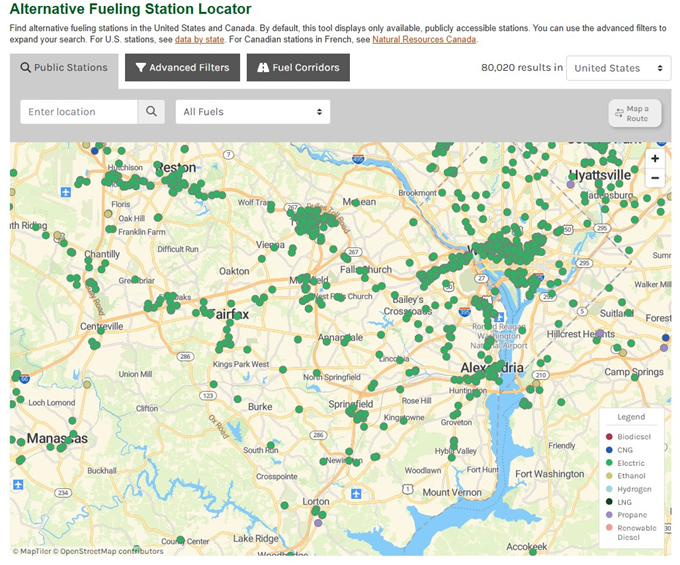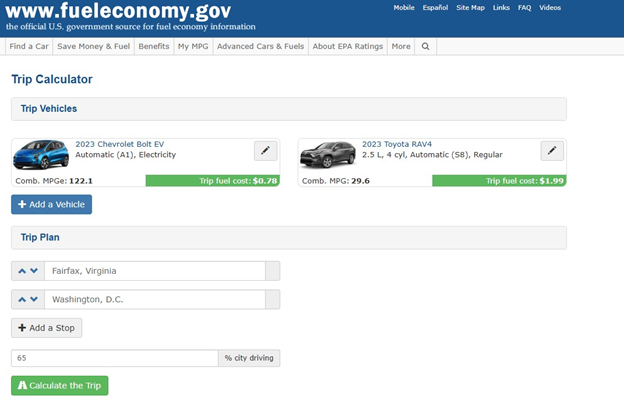Post written by Julie Gurnee, Mitigation Specialist, OEEC
In 2021, one of our family cars was nearing the end of its lifespan, and we needed to start looking for a new car. I really wanted to buy an electric vehicle (EV) but became overwhelmed with questions and concerns, ultimately opting for a hybrid instead. Last year, when upgrading our second aging car, I did my research and decided to go all-in on an EV. Here’s what I know now that I wish I had known in 2021.
I want to buy an EV, but…
…I drive every day and I’m worried about driving range.

Range anxiety is a real thing, but let's look at some numbers. In this scenario, you would be charging at home with a standard 120V outlet, the same type of outlet you would plug your phone charger into.
The average commute in the DC metro area is 15 miles round trip, but let’s bump it to 20 miles to be safe. The average range of an EV in 2023 was 270 miles (and increasing). To be conservative, we’ll assume an 80% charge gives you 200 miles.
If you start your day with 200 miles and only commute to work, you’ll come home with 180 miles left. Plug it in and after 12 hours (charging at about 4 miles per hour), you’ll be back at 200 miles by morning — essentially starting each day with a full tank.
But that’s probably not real life.
Life isn’t just commuting; it’s also errands, kids and other activities. On a big day, that may add an extra 20 miles to your day. And, because of activities, maybe you can only charge for 10 hours. In the morning, you are still charged up to 200 miles. So, say you add another 10 miles to that for a total of 50 miles, you are still only "losing" 10 miles a day.
So, if you drive 50 miles every Monday through Friday, you still wake up Saturday morning with 150 miles left! Now let’s consider how you’re going to charge your EV.
…I don’t have a Level 2 charging port at home.
The added cost and hassle of installing a home charging station might be what pushes you back to a gas vehicle, but the reality is, you probably don’t need a dedicated EV charger at home. Having a Level 2 charger is a luxury, but it’s not a necessity.
In our scenario above, we considered a 120V outlet, which should work for most people, but you may have a longer commute or no home-charging access. If this is the case, you may need to charge your vehicle with a public charger.
In Fairfax County, there are 369 public charging locations, including 1,156 Level 2 ports and 239 fast chargers. These numbers are growing daily. You can find stations on PlugShare.com, Google Maps, and other platforms. Some public chargers are free, while others charge a fee, but public charging is surprisingly easy and affordable.
…but I’m worried about the cost to charge my car.
Using our numbers above and averaging 1,000 miles per month (which you probably aren’t), charging at home would cost about $50 extra on your electricity bill. Dominion Energy and NOVEC offer programs to reduce these costs.
Public chargers vary, averaging around $0.24/kWh. So, if you’re driving 1,000 miles per month and only using public chargers, your monthly cost would be about $70. Plus, some public chargers are free or lower than average, which could reduce your costs even further.
A good way to compare how much your daily commute or a common car trip you take would cost with an EV vs a gas car, is by using the Fuel Economy Trip Calculator. You input the vehicles (we recommend using your current car and the EV you’re considering), and the locations, and the calculator shows you the trip cost.
By and far, the cost of an EV is lower than the monthly cost to fuel a traditional gas vehicle. For the same mileage per month, it would cost around $150 to fill up a gas tank (when comparing model year 2023 MPG numbers.)
…I want to take road trips.
Here’s the honest truth — road trips with an EV require planning. I took a 1,100-mile round trip with my 10-year-old daughter, and while we had to adjust plans a couple of times, it was still a great drive. Apps like PlugShare help plan your route and find Level 2 and DCFC chargers (sometimes referred to as Level 3, these are the super-fast chargers). DCFC chargers, which can charge your car while you grab food and take a break, are key for long trips. The EV charging infrastructure is expanding rapidly, making road trips easier every year.
The other thing to remember is that the infrastructure is constantly growing. The Alternative Fuel Corridors is a growing program that supports alternative fuel charging along major highways across the U.S. The numbers of EV charging stations is growing and the technology is always advancing.
… I love the features of my gas car.
- No more gas stations: No standing in the cold or running late because I need gas. Bonus — I save money on snacks my kids would beg for at the gas station.
- Instant acceleration: Most EVs go 0-60 in under five seconds.
- It’s quiet: With no engine noise, the cabin is calm and peaceful while driving.
- Luxury climate control features: Heated seats and a heated steering wheel make winter driving much more comfortable. While these are not only on EVs, heating the seats is more energy-efficient than heating the whole car, so these features are standard on many EVs.
So, is now a good time to go electric? Absolutely. There are more vehicle options than ever, plenty of charging locations, and technology keeps improving. I’ve been happy with my EV and highly recommend making the switch!
Want to learn more?
Visit our Electric Vehicles page for more information, including incentives and tax credit programs that can lower the cost!

Julie Gurnee joined OEEC in 2024 and is supporting the implementation of Fairfax County’s Community-Wide Energy and Climate Action Plan. Her work primarily focuses on advancing electric vehicle adoption in Fairfax County. Julie holds a degree in biology and ecology from the University of Montana and has over a decade of experience in outreach and education for Fairfax County.
Climate Matters is the blog of Fairfax County’s Office of Environmental and Energy Coordination, where we share stories, insights and information related to climate change and environmental sustainability. Posts are written by knowledgeable and passionate OEEC staff members and guest authors. To read all blog posts, visit Climate Matters.



